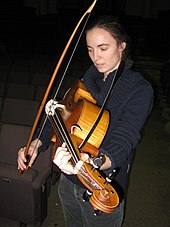The violoncello da spalla, known informally as the cello da spalla, is a small cello played braced against the shoulder.[1]

The violoncello da spalla was designed to be played by violinists, who have limited experience playing instruments such as the viola da gamba or cello, which are held in a vertical position fixed between legs. The violoncello da spalla is held on the shoulder and chest, and is larger than the viola.[2]
There are also numerous instances of suites, serenades, divertimenti, and cassations that begin and/or end with marches. If these marches were to get the players in or out, the bass lines could have been played on these instruments, as well as on procession cellos which are regular cellos with a tiny hole under the neck where the player can attach a hook and a strap.
Possible use by Bach
editBecause of the variety in terminology used in the eighteenth century, it can be difficult now to determine exactly what instrument was intended in specific instances. The terms "violoncello da spalla" and "viola da spalla" tend to appear in theoretical works rather than as instrument designations from composers. However, it is possible that J. S. Bach, and perhaps other composers, might have intended the violoncello da spalla in cases where the "violoncello piccolo" is specified. This term, "violoncello piccolo", features in many of the Bach cantatas, with the parts written in a variety of clefs (bass, tenor, alto and soprano). The variety of clefs has been taken as a representation of the instrument's relatively wide range.[3] The five-string version of the instrument may have been what Bach had in mind for performing his Cello Suite No. 6 (which was intended for an instrument with the tuning CGdae'). The High E String on the Violoncello da Spalla also allows for the possibility of playing Violin Music an Octave lower than written (e.g. the Bach Violin Sonatas & Partitas).
Musicians
edit- François Fernandez
- Sigiswald Kuijken
- Sergey Malov
- Ryo Terakado
- Dmitry Badiarov
- Samuel Hengebaert
- Olav Johansson
- Mikael Marin
- Andrew Gonzalez
- Makoto Akatsu
- Gregorio Ibáñez Gómez
See also
editReferences
edit- ^ Barnett, Gregory (1998). "The Violoncello da Spalla: Shouldering the Cello in the Baroque Era". Journal of the American Musical Instrument Society. 24: 81–106.
- ^ Badiarov, Dmitry. “The Violoncello, Viola da spalla and Viola pomposa in Theory and Practice.” The Galpin Society Journal, vol. 60, 2007, pp. 121–145. Online at JSTOR, [1]. Accessed 3 Sept. 2021.
- ^ "Violoncello piccolo". Bach Cantatas website. Retrieved 2017-07-13.